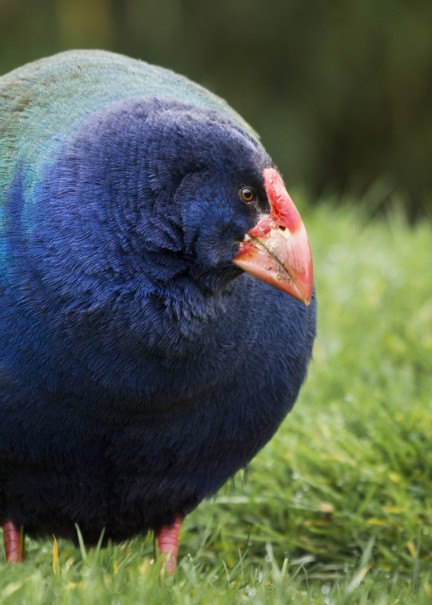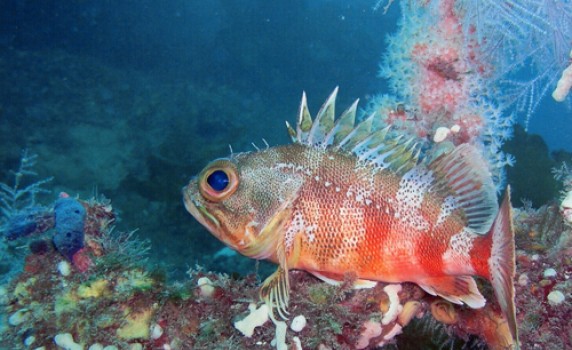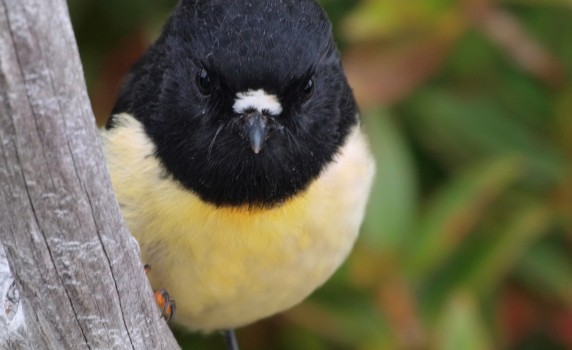Fiordland's Incredible Birdlife
For more than 60 million years, New Zealand’s geographical isolation provided a safe haven for a diverse population of bird species. Existing on a remote island and free from ground-dwelling predators and mammals, New Zealand’s bird species flourished, and many lost the ability to fly. With the arrival of humans and their animals, these flightless birds were decimated. Just 16 species of flightless birds exist in New Zealand today. Many of the rarest and endangered species are found right here in Fiordland.
Takahē
The takahē is an example of a bird that developed to be much larger and flightless compared to its distant cousins in the rail species (ground-dwelling). The takahē was in fact thought to be extinct for more than forty years before it was rediscovered in the mountains of Fiordland in 1948. Te Anau is now home to the breeding recovery programme for takahē. It is also possible to catch a glimpse of, and even feed the shy takahē at Te Anau’s Punanga Manu o Te Anau / Te Anau Bird Sanctuary, managed by the Department of Conservation.
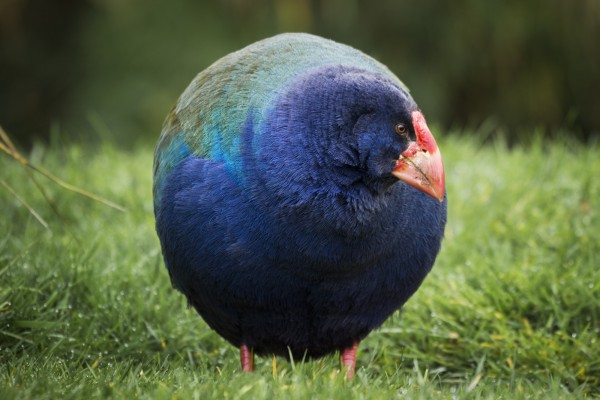
Takahe - Douglas Thorne
A critical preservation project is currently underway In the tussock basins of the Murchison Mountains in Fiordland. This remote area is off-limits to everyone except DOC staff and scientists checking on the last remaining wild population of takahē. The takahē is a large flightless native New Zealand bird. It was thought to be extinct for more than forty years before being rediscovered in the mountains of Fiordland in 1948. The project is regarded as one of Fiordland’s greatest conservation success stories. It is also possible to catch a glimpse of the shy takahē at Te Anau’s Punanga Manu o Te Anau/Te Anau Bird Sanctuary, managed by the Department of Conservation.
Kākāpō
Fiordland was also the final refuge for the world's only flightless parrot, the kākāpō. The world's rarest and heaviest parrot, kākāpō survived in Fiordland until the early 1980s but now only exist in offshore island populations and wildlife centres. Both of these rare bird species are now part of a recovery programme managed by the Department of Conservation.
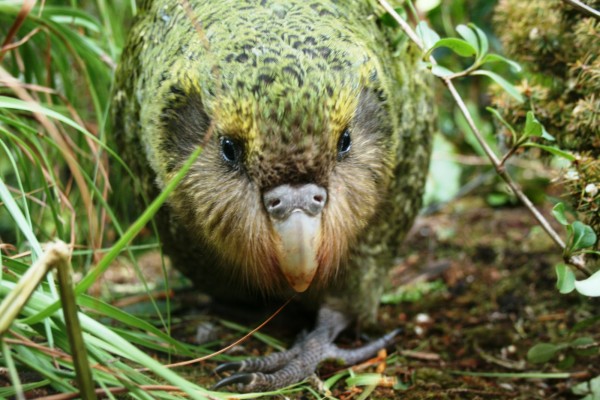
Kakapo - Pania Dalley
Kiwi
There are kiwi in Fiordland – sometimes heard as close as Brod Bay on the Kepler Track, often on the Milford Track, and there are several populations on islands on Lakes Te Anau, Manapouri and in Tamatea / Dusky Sound. There is no direct management of the Fiordland’s kiwi (tokoeka), but work is being done to eradicate pests from areas where the kiwi are known to live. This includes Resolution and Secretary Islands as well as the Murchison Mountains, near Te Anau.
Tawaki - Fiordland Crested Penguin
The tawaki Fiordland crested penguin is one of three penguin species found on the New Zealand mainland and is one of the rarest penguins in the world. The small yet shy tawaki inhabits the southwestern coastlines of the South Island as well as Stewart, Codfish and Solander Islands. Tawaki can be found within the vast fiord systems of Fiordland National Park choosing caves, crevasses and dense bush as nesting spots safe from disturbance by humans or predators. Despite being a protected species, the tawaki is considered vulnerable with an estimated 2,500 - 3,000 nesting pairs left in the world. In recent years, it was thought there were only around nine breeding pairs in Milford Sound, but further investigation carried out by the Tawaki Project has revealed this number may be closer to 180. The best time of year to see tawaki in Fiordland (from a distance) is during the breeding season from July to November. It may also be possible to see them during the moulting season which runs from mid-January to early March.
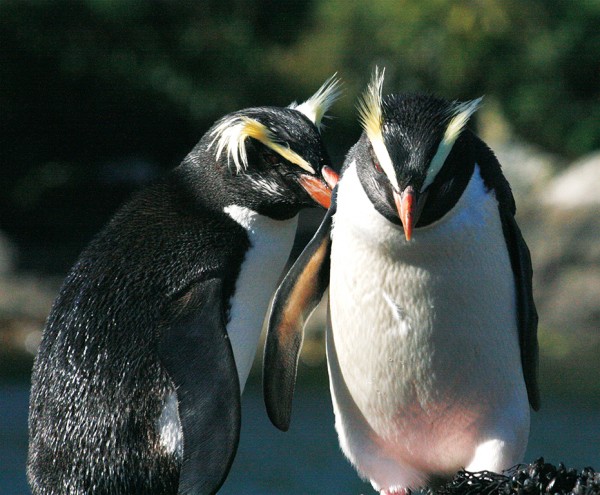
Tawaki Fiordland Crested Penguin
THE FORESTS OF FIORDLAND
Fiordland is home to a diverse range of forests and vegetation. This lush and rich landscape supports everything from immense and ancient beech and podocarp forests, to unique alpine species and vast areas of lush wetland.
Deep within Fiordland, much of the forest consists of the larger beech and podocarp varieties (Hall’s Totara, Rimu and Miro). These mighty trees cling impossibly to steep faces of hard rock. Here, it is only a thin layer of rich, peaty humus and moss which anchors huge trees to steep slopes. Tree avalanches are common.
A range of beech species are found within Fiordland with red and mountain beech growing around the eastern lakes and in the Eglinton Valley. Silver beech is widespread, sometimes growing in association with the podocarps.
In the wetter areas, this forest type has luxuriant understorey shrubs, tree ferns, mosses and lichens. Above the 900-metre bushline, snow tussocks dominate with showy alpine daisies, buttercups and other alpine herbs.
For anyone interested in New Zealand’s plant heritage, forests, alpine environments or nomenclature in general Fiordland is the place to visit.
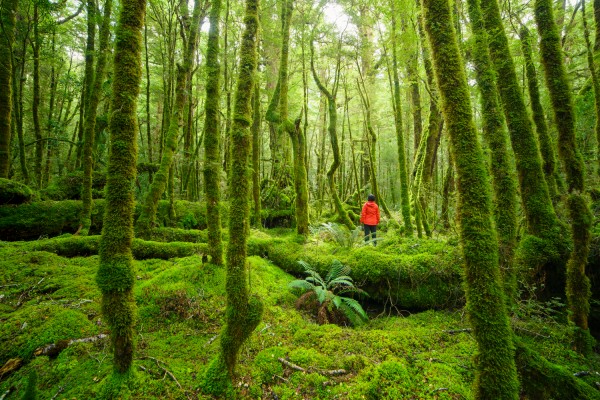
Fiordland forest - Will Patino
FIORDLAND’S UNIQUE UNDERWATER ENVIRONMENT
The underwater environment in New Zealand’s fiords is one of the most intriguing and unique in the world. As rainfall drains through Fiordland’s lush forests, it becomes stained with tannins, turning the water the colour of strong tea. This top layer of dark freshwater doesn’t mix with the saltwater of the fiords below it and creates a natural light screen to block light getting to lower depths.
By limiting the amount of light able to penetrate through the water, almost all of the fiords’ marine life lives within 40 metres (131 feet) of the surface. As a result, light-sensitive species that normally live at great depths are found close to the surface in Fiordland waters. This 40-metre band is calm, clear and relatively warm and is the ideal home for sponges, corals and fish of subtropical, cool water and deep water varieties.
Fiordland’s underwater environment supports one of the world's biggest population of black coral trees - about seven million colonies, some of them up to 200 years old. It is also home to brachiopods; primitive clam-like animals that have been bypassed by evolution, remaining unchanged in over 300 million years. Bottlenose dolphins, New Zealand fur seals, Fiordland Crested Penguins and little penguins are also resident in the fiords. If you take a dive in Piopiotahi / Milford Sound, you have the opportunity to see many other species like crayfish, spiny dog sharks, sea dragons, nudibranch, tube worms, sponges and walls of yellow zoanthids. The New Zealand fur seal inhabits Piopiotahi / Milford Sound and is often curious to see where divers' bubbles come from. An easier way to witness the spectacle of Black Coral and other unique species is with a visit to the Milford Sound Underwater Observatory.
FAQs about Fiordland
Where can I see Fiordland Crested Penguins?
Patea / Doubtful Sound, Piopiotahi / Milford Sound and the other fiords of Fiordland all provide opportunity to see Fiordland Crested Penguins. The best time to see them is July - November.
Can I stay in Fiordland National Park?
Yes. Te Anau and Manapouri are "base camp" for your Fiordland National Park visit.
How big is Fiordland?
Fiordland National Park is now over 1.2 million hectares in size, and encompasses mountain, lake, fiord and rainforest environments.
What is there to do in Fiordland National Park?
Fiordland is most famous for hiking and walking. Three of New Zealand's Great Walks are found in Fiordland (Kepler, Milford and Routeburn) and there is a huge number of day walk options. Te Anau and Manapouri offer a huge range of activities to do on the lake.
What walks are there in Milford Sound?
There is a short foreshore walk (up to 30 minutes) linking Milford Sound Lodge to the boat terminal, passing the airport on the way. There are several walks to do along the Milford Road. You can also take a guided half-day walk on the Milford Track from Milford Sound, pre-bookings essential.
